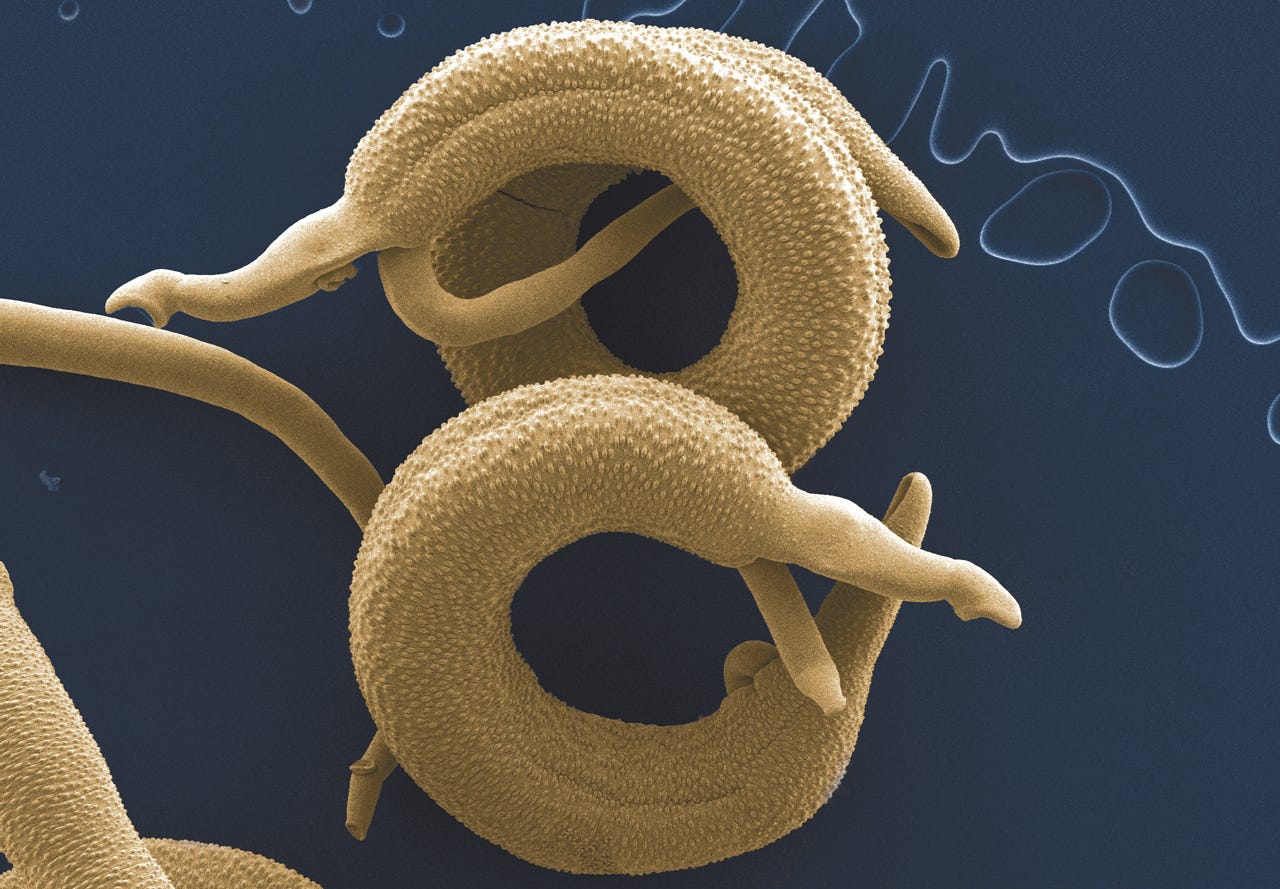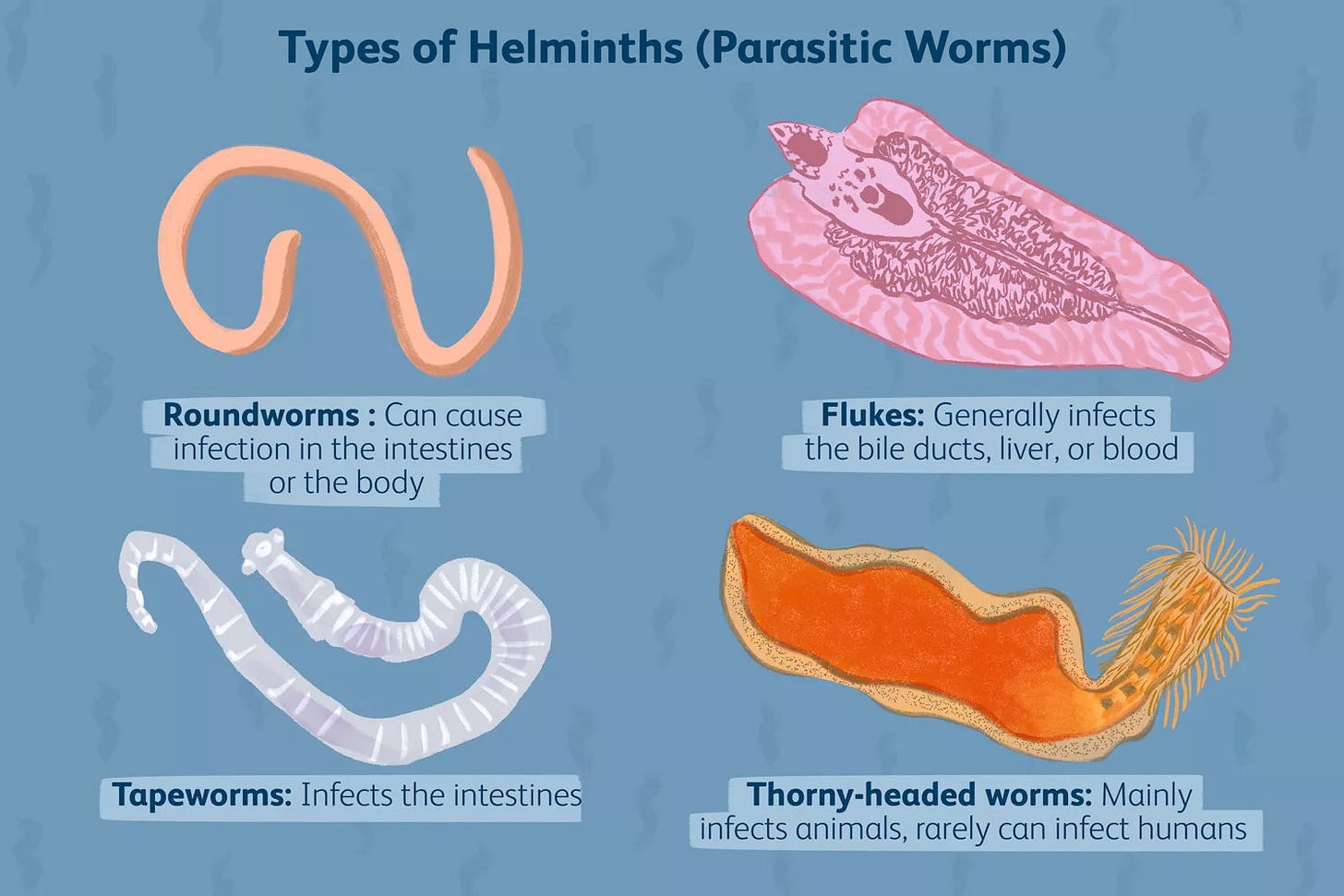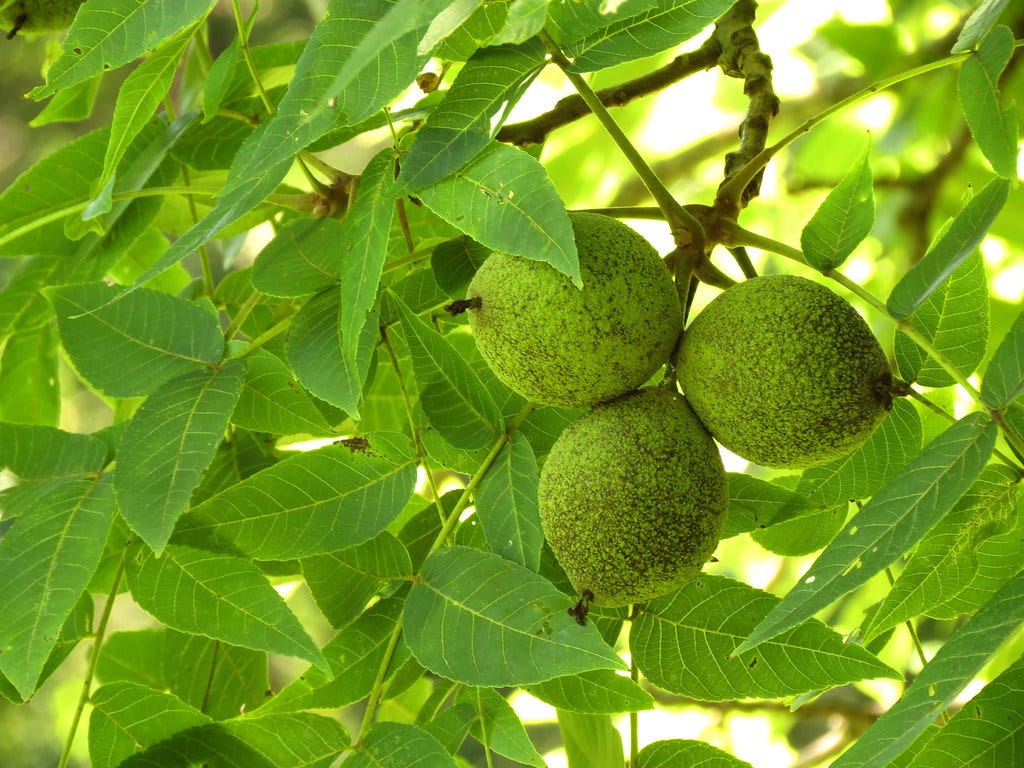Parasites 101: Helminths and What Herbalists Do About Them
learn how parasitic worms affect the body, why they often go undetected, and what herbalism has to say about their role in chronic symptoms.
I remember it like it was yesterday.
Parasitology class. Dark lecture hall. A projector humming as a slightly crooked slide flickered onto the wall. And there I was—slumped in a stiff wooden chair, trying to stay conscious while my eyes glazed over another diagram of a parasite’s lifecycle.
This was in 2010, and yes, my medical school still used actual projection slides. No digital convenience here—just the gentle whir of the carousel and the growing sense that I might actually bash my head into the desk if I had to memorize one more mode of transmission.
What made it worse? We had to draw every single parasite egg in a little notebook. A graded notebook. Every whipworm, every tapeworm, every barely-differentiable blob under the microscope got its moment of artistic glory. It wasn’t just parasitology—it was the Art of Parasitology 101.
And through it all, I remember thinking, This is ridiculous. I’ll never need this. I’m not going to be treating parasites. I live in the U.S., for goodness’ sake.
Spoiler: I was wrong.
In this introductory article, we’ll explore what helminths are, how they impact the human body, and why understanding them is crucial to holistic wellness. You’ll learn the basics of parasitic worms, how they cause symptoms, and why herbal medicine has a long-standing tradition of addressing them.
But we’re only scratching the surface.
This Friday, we’re going deeper—literally.
Our post for The Buffalo Herbalist Community will break down the pathophysiology of helminths: what these worms are doing inside your body to cause symptoms like bloating, fatigue, and nutrient depletion.
We’ll also explore black walnut and wormwood in more detail, two powerful herbs used in traditional parasite protocols, complete with printable materia medicas and a review of popular herbal parasite cleanse kits. Are they really legit?
If you’re curious about what's crawling under the surface and how to address it naturally, you won’t want to miss it!
Upgrade your subscription to unlock this Friday's exclusive post and gain access to our growing library of in-depth herbal content.

Parasites in the Modern World: It’s the Worms We Should Be Watching
When we hear the word “parasite,” most of us picture something exotic—something you'd pick up while backpacking through a rainforest or drinking questionable water abroad. But the parasites we actually need to be paying attention to here in the States?
They're worms.
Specifically, helminths—a broad category that includes roundworms, hookworms, whipworms, and more. These are the heavy-hitters in terms of parasitic infections in developed countries, and yet, they’re rarely talked about.
That’s why I want to spend a little extra time focusing on these. Because when we hear terms like anti-parasitic herbs, what we’re often really talking about are antihelminthic herbs.
Sound familiar?
You’ve probably seen that word—antihelminthic—on a materia medica sheet or tucked into the margin of an herb book and assumed it just meant “kills parasites.” But it’s not quite that general. It refers specifically to herbs that target parasitic worms.
And there’s a big difference between herbs that tackle protozoa, blood parasites, or skin-burrowing critters and those that are effective against helminths. A lot of the most popular herbs in the "cleanse" space are, in fact, working on worms.
So let’s talk about them. Not just the worms themselves, but where they’re hiding, who’s most at risk, and why this isn’t just a developing world issue. Because as much as I wanted to forget those parasite slides forever… it turns out, they were preparing me for something after all.
Worms in the Walls: Yes, Even in the U.S.
Let’s talk about something most folks in the States have long stopped thinking about: worms.
Not the garden kind. I mean parasitic worms—helminths—that quietly infect the human body, stealing nutrients, damaging organs, and often going completely undetected for years.
You might be thinking, “That’s a third-world problem, right?”
Not quite.
Up until the 1980s, hookworm infections in the American South were shockingly common—up to 40% of the population in some areas. Since then, the conversation has largely gone silent. We stopped looking, so we assumed the problem was gone.
But here’s the uncomfortable truth: the conditions that allowed these worms to thrive—poverty, poor plumbing, warm climate, and neglected rural communities—still exist. According to estimates from the American Community Survey, over 1.2 million people in the U.S. still don’t have access to adequate plumbing. That’s not a statistic from another continent—that’s here at home.
And yet, routine screening for helminths isn’t happening. In fact, only Texas currently lists soil-transmitted helminths as a reportable condition, and even that doesn’t include information on where or how people were infected. With no surveillance, we have no clue how widespread the problem is.
Meanwhile, undiagnosed worm infections may be contributing to chronic fatigue, gut issues, nutrient deficiencies, and even developmental delays in children—all without ever being on a doctor’s radar.
Halting harmful helminths | Science
It’s Not Just Us—It’s Everywhere
The U.S. isn’t alone in ignoring helminths. Despite affecting hundreds of millions of people globally, parasitic worms are still one of the most overlooked categories of disease, even in many developed countries.
Why? Because for a long time, they were considered “solved”—a thing of the past. But parasites are incredibly resilient. They’ve evolved to live silently inside us, often without causing obvious symptoms until the damage is already done. And now, climate change, global migration, and drug resistance are creating the perfect storm for these infections to spread—again.
Let’s put it in perspective:
Over 800 million people are infected with roundworm
Nearly 465 million with whipworm
Around 440 million with hookworm
And many more with less commonly discussed infections like Strongyloides, which can live in a human body for decades, or Toxocara, often picked up from pet feces and linked to vision loss and cognitive delays in children
This isn’t a niche issue. It’s a widespread, quiet problem that hides in plain sight—especially among those most vulnerable: children, the immunocompromised, and people living in poverty, whether rural or urban.
So... What Are Helminths, Anyway?
Let’s get into the basics. Helminths are parasitic worms—multi-celled organisms that set up residence in the human body, often in the gut. They’re not like protozoa, which are single-celled and can multiply inside the body. Most helminths can’t reproduce within us, but they still do plenty of damage while they’re around.
Intestinal Parasites - Health Well Done
There are three main types:
Nematodes (roundworms)
Cestodes (tapeworms)
Trematodes (flukes or flatworms)
The most common culprits? Soil-transmitted helminths (STHs), also called geohelminths:
Ascaris lumbricoides (roundworm)
Trichuris trichiura (whipworm)
Ancylostoma duodenale and Necator americanus (hookworms)
These infect over a billion people globally—and while they rarely kill, they’re responsible for chronic fatigue, nutrient depletion, growth stunting in children, and even cognitive delays. In other words: they slowly chip away at your health over time.
How Do Worms Get In—and What Happens When They're Inside?
Each worm has its own sneaky way of entering the body.
Ascaris and Trichuris come in through the mouth, usually from contaminated food, unwashed hands, or poor sanitation.
Hookworms? They enter through the skin—often through bare feet. From there, they travel through the bloodstream to the lungs, get coughed up, and are swallowed before landing in the intestines.
Strongyloides can infect through the skin or orally, and once inside, they can persist for decades.
Schistosomes, another kind of fluke, are transmitted through contact with freshwater—usually while swimming or washing clothes in infested water.
Once these worms settle in, they’re not just passive residents. They can:
Steal nutrients
Trigger chronic inflammation
Migrate to the liver, lungs, or brain
Cause anemia, malabsorption, and immune disruption
Lead to long-term issues in children like stunted growth or cognitive delays
They don’t have to kill you to do damage. Most helminth infections are chronic, not acute—which makes them harder to detect, and easier to ignore.
And yet, for centuries, herbalists and traditional healers have understood the subtle toll these parasites take—developing plant-based protocols aimed at gently but effectively restoring balance.
From bitter tonics to antiparasitic compounds found in roots and barks, the natural world has long offered tools to help us reclaim our internal terrain.
Let’s get into the herbs:
Black Walnut (Juglans nigra): A Bold Bitter for Bugs
If you’ve ever done a parasite cleanse or peeked into a tincture blend labeled “anti-parasitic,” chances are Black Walnut was front and center.
This dark, bitter herb isn’t one for subtlety—it’s strong, slightly mysterious, and has been used for generations to clean house, both inside and out.
Traditionally, the green hull of the unripe walnut has been used to help with:
Worms and parasites – roundworms, tapeworms, possibly flukes
GI infections – food poisoning, diarrhea, dysbiosis
Chronic skin conditions – especially those linked to poor digestion or elimination (eczema, acne, ringworm, impetigo)
It’s deeply astringent, antimicrobial, and bitter—an herb that says, “We’re not messing around.”
Some herbalists, like Matthew Wood, note its high iodine content and suggest a possible action on the thyroid, especially in slow, sluggish constitutions—but that connection is more energetic than clinically proven.
A Few Things to Know:
Taste & Energetics: Bitter, pungent, cooling, astringent
Main Actions: Anthelmintic, antimicrobial, alterative, mild laxative
Dosing: Typically low (e.g. 10–40 mL/week of tincture), and short-term
Cautions: Avoid if allergic to tree nuts; not for use during pregnancy/breastfeeding!!
While it’s not a daily tonic, Black Walnut shines in short bursts, especially during seasonal cleanses or when dealing with stubborn bugs that don’t respond to gentler herbs.
Katja Schulz treegrow
Wormwood (Artemisia absinthium): Bitter, Bold, and Not Here to Coddle
If Black Walnut is the tough-talking gut guardian, Wormwood is its sharp-tongued herbal cousin—bitter, cleansing, and unapologetically direct. Traditionally used in both European and Middle Eastern medicine, wormwood has long been considered one of the most powerful anthelmintics in the herbal world.
It’s not here for a gentle nudge. Wormwood is a classic bitter, stimulating digestion, bile flow, and peristalsis—while also showing strong affinity for pinworms, roundworms, and general gut-based infections.
David Hoffmann calls it an “especially powerful remedy” for worm infestations. And it’s not just about parasites—its tonic, antimicrobial, and anti-inflammatory properties make it a go-to for fevers, digestive sluggishness, and lingering infection.
Part Used: Leafy flowering tops
Constituents:
Essential oils (thujone, absinthol, isovaleric acid)
Bitter sesquiterpenes
Flavonoid glycosides
Main Actions: Anthelmintic, bitter tonic, carminative, anti-inflammatory
Energetics: Cold, intensely bitter, drying
Dosing:
Tincture: 1–4 mL up to 3x/day
Infusion: Up to 3x/day (very bitter—best blended or capped for taste)
A Note on Thujone
Wormwood contains thujone, a compound with neurological effects in high doses. While small, properly prepared doses are considered safe short-term, this isn’t a herb to take daily for months on end. Avoid during pregnancy and breastfeeding, and use only under guidance if you have a seizure disorder or take medication that lowers the seizure threshold.
Wormwood’s power is in its precision: it targets sluggish, infected, stagnant states—especially in the gut—and supports the body in clearing them out. On Friday, I’ll walk through exactly how wormwood works in the body and where it shines (and where it doesn’t), plus how to use it in formulas with other cleansing herbs like black walnut and clove.

Parasites have long existed in the shadows—quiet invaders shaping our health in ways we're only beginning to understand. While often overlooked in modern discussions, their influence on immunity, digestion, and even mental clarity is profound. As we reconnect with ancient herbal traditions and modern scientific inquiry, the question becomes: are we paying enough attention to what may be quietly living within us? Understanding helminths isn't just about ridding the body of worms—it's about reclaiming sovereignty over your internal ecosystem.
If you found this topic as fascinating (and mildly unsettling) as I do, don’t forget to like, restack, share, or drop a comment—I’d love to hear your thoughts or personal experiences with herbal parasite protocols.
This Friday’s paid post will go deep into the pathophysiology of helminths—how these worms actually cause damage in the body, and how herbs like black walnut, wormwood, and others help us fight back.
We’ll also explore the big question: are the parasite cleanses on the market actually legit? And if not, how can we tell?
As always, thank you for reading and supporting this little herbal corner of the internet. If you’d like to support this publication, but aren’t ready to commit to a monthly subscription - you can buy me a coffee here. Nothing is expected, everything is deeply appreciated.
Until Friday—
🌿 Agy
The Buffalo Herbalist
Bibliography
Wood, Matthew. The Earthwise Herbal: A Complete Guide to Old World Medicinal Plants
Hoffmann, David. Medical Herbalism
Bone & Mills. Principles and Practice of Phytotherapy
American Botanical Council –
https://www.herbalgram.org
Natural Medicines Database
USDA Plant Database – Juglans nigra profile
Adak, M., & Kumar, P. (2022). Herbal anthelmintic agents: A narrative review. Journal of Traditional Chinese Medicine, 42(4), 641–651. https://doi.org/10.19852/j.cnki.jtcm.2022.04.007
Haque, R. (2007, December 1). Human intestinal parasites. U.S. National Library of Medicine. https://pmc.ncbi.nlm.nih.gov/articles/PMC2754014/
Helminthiasis. (2025, January 1). PubMed. https://pubmed.ncbi.nlm.nih.gov/32809360/
Hotez, P. J., Brindley, P. J., Bethony, J. M., King, C. H., Pearce, E. J., & Jacobson, J. (2008). Helminth infections: The great neglected tropical diseases. Journal of Clinical Investigation, 118(4), 1311–1321. https://doi.org/10.1172/jci34261
Lynn, M. K., Morrissey, J. A., & Conserve, D. F. (2021). Soil-transmitted helminths in the USA: A review of five common parasites and future directions for avenues of enhanced epidemiologic inquiry. Current Tropical Medicine Reports, 8(1), 32–42. https://doi.org/10.1007/s40475-020-00221-2
Intestinal worm image: Intestinal Parasites - Health Well Done







Thank you Agy! Are there any testing options to find out if someone has a parasite?
Thank you❣️